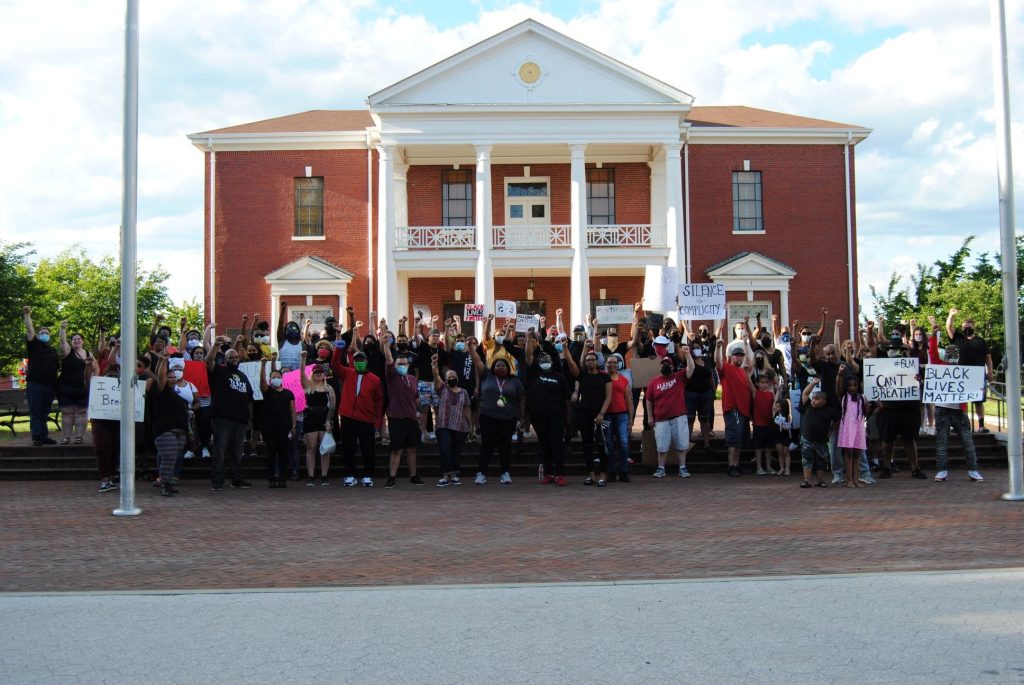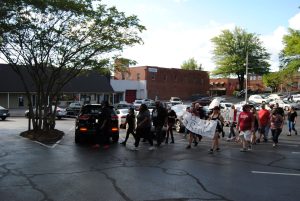
By Brandon Martin
“I’m not sure if I know if there is a right way to go about things,” Martinsville native Sweettavii Hairston said the day after she organized a Memorial Walk in Uptown Martinsville in memory of a Minnesota man.
George Floyd, 46, died May 25 in Minneapolis. A video of an encounter with the police showed a white officer kneeling on an African American man’s neck, while ignoring the handcuffed man’s repeated pleas for air. Floyd was unresponsive when he was placed on a stretcher.
The four officers involved in the incident were fired and by Wednesday, all had been charged.
Hairston said after her husband, Cornelius, showed her the video, she was at a loss when deciding what she could do to help.
“I said there was nothing we could do,” Hairston said. “I was angry, but I was more sad that people had to die to expose this evil to the world.”
After consulting many community leaders and friends, like Ariel Johnson and Martinsville City Council member Jennifer Bowles and Vice Mayor Chad Martin, Hairston said she decided to organize the May 31 walk.
“It was a very peaceful demonstration to support those lives lost to racism and police brutality. It was nice to be around individuals who understood the pain and sentiment of the families and others, Bowles said. “This was not a black versus white event, but an everybody against racism walk.”
Hairston said that the walk was “amazing,” and that she couldn’t have asked for a better way for it to turn out. “I just really want to thank everyone that helped me and encouraged me because I think our community really needed it.”
Bowles also said she was thankful for the supporters, but that it “was very shocking and disappointing to have a truck of people antagonizing those in the walk by yelling racial slurs and profanities, especially when those participating in the walk were calm.”
Fortunately, the Martinsville City Police Department handled the situation well and stopped these individuals from further disturbing the event, Bowles said.
Hairston said she was very appreciative of all the support from law enforcement who attended in solidarity of the walk, which she said was intended to “change the mindset. To display love for your neighbor and we are working towards a better future.”
The local walk is a drastic contrast to similar events across the country, some of which have led to violent encounters between law enforcement and protestors, as well as property damage.
“People are mad. I won’t judge them, I can’t. I don’t live in those areas, so I don’t know what they are experiencing, but I do know what was right for my community,” Hairston said.
“I support the organizer’s choice to have a walk instead of a protest,” Bowles said. “There are those in society today who hear the word ‘protest,’ and immediately have negative connotations. In my opinion, the organizer wanted to bring more people together and unify our community by collectively agreeing racism is wrong. I do not believe that point is debatable.”
She added that “although I was not there in my official capacity as a city council member, I know I still represent all citizens. I will always support any citizen, group, or organization spreading their message in a peaceful and respectful manner.”

Speaking on the ongoing Black Lives Matter protests that began in 2013 following the acquittal of George Zimmerman in the murder of Trayvon Martin, Hairston said she doesn’t want the underlying message to be misconstrued.
“When we say ‘Black Lives Matter,’ we know that all lives matter. Of course we know that,” she said. “What we are saying is that we don’t feel like our lives matter when people can murder us in the streets and get off with a slap on the wrist. Yes, undoubtedly all lives matter. We just want people to recognize that ours do too.”
She reiterated that she doesn’t know the right answer to an undoubtedly a complex question: How far is too far when one believes that their basic human rights have been violated and they feel there is nothing that they can do to change it?
Bowles said that she does “not condone any acts of violence against a person or our community.”
Still, the fact remains “protesting comes in many shapes and forms, and we have seen throughout history the effects peaceful protesting has had on legislation and actionable change in our communities,” said Bowles. “We’ve seen many examples of folks looting and destroying property to enact change as well, such as the Boston Tea Party Riot. Rioting is not a new phenomenon and happens even when people are supporting a cause other than winning or losing a sporting event.”
The Boston Tea Party is potentially the most widely known example of destruction of property, and led to significant changes in American history. In response to the destruction of 342 crates of tea stored in ships coming from England by 60 settlers, King George III closed the Boston Harbor and established the Intolerable Acts, further pushing the colonies to revolt.
Following the War of Independence and enshrined in the Bill of Rights, the First Amendment states that “Congress shall make no law respecting an establishment of religion, or prohibiting the free exercise thereof; or abridging the freedom of speech, or of the press; or the right of the people peaceably to assemble, and to petition the Government for a redress of grievances.”
These rights aren’t blanket immunities; however, and “police and other government officials are allowed to place certain narrow restrictions on the exercise of speech rights,” according to the American Civil Liberties Union (ACLU).
Some examples of restrictions are for defamation, perjury, and incitement to imminent lawless action.
Throughout history, American’s have largely practiced their right to protest in a peaceful, yet controversial manner.
Former San Francisco 49ers Quarterback Colin Kaepernick drew national attention in 2016 when he began a pre-game routine of kneeling for “The Star Spangled Banner.” His primary goal was to draw attention to a series of African-American deaths at the hands of law enforcement.
“I am not going to stand up to show pride in a flag for a country that oppresses black people and people of color,” he said at the time. “To me, this is bigger than football and it would be selfish on my part to look the other way. There are bodies in the street and people getting paid leave and getting away with murder.”

He said that he chose to kneel to show more respect to former and current U.S. military members while still protesting during the anthem after having a conversation with former NFL player and U.S. military veteran Nate Boyer.
This however, did not prevent controversy surrounding the protest, with many viewing his act as disrespectful to the country and fallen soldiers and calling for Kaepernick to be removed from the NFL.
Controversy in political statements isn’t unique to racial issues either.
Earlier in the year, about 100 Patrick and Henry county residents joined a rally in Richmond to show their support for the Second Amendment following months of debate in localities across the Commonwealth about gun rights.
During the rally, Second Amendment supporter Brandon Wear said he thought that the then-proposed actions of Gov. Ralph Northam are “wholly unconstitutional. It’s incredibly frustrating to watch legislators ignore the will of thousands of Virginians and I came here to see everyone make their voices heard.”
Most rally-goers carried firearms while attending the event, and there were no reported incidents. However, the move still sparked controversy – and in addition to already heightened opinions on the issue — the protest also occurred on Martin Luther King Jr., day.
Patrick County Republican Committee Unit Chair Wren Williams said the Virginia Citizens Defense League’s annual Lobby Day was meant to be in the spirit of King, and thus the day always fell on the holiday, regardless of the issue being lobbied at the time.
Still, some community leaders like the Rev. Tyler Millner, pastor of Morning Star Holy Church in Axton, said that he “was even more concerned after guns were brought to the Capital on Martin Luther King’s holiday, the drum major for peace.”
Since protests are designed to voice disapproval of something, controversy will always likely follow and when tensions rise to the level of violence, law enforcement may be called to disperse the crowd, but there are some steps people can take if they believe their rights are being violated.
“When you can, write down everything you remember, including the officers’ badge and patrol car numbers and the agency they work for,” according to the ACLU’s website. “Get contact information for witnesses. Take photographs of any injuries. Once you have all of this information, you can file a written complaint with the agency’s internal affairs division or civilian complaint board.”



